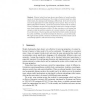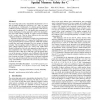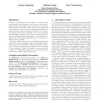216 search results - page 42 / 44 » Formal Proofs for the Security of Signcryption |
PKC
2010
Springer
13 years 11 months ago
2010
Springer
In many practical settings, participants are willing to deviate from the protocol only if they remain undetected. Aumann and Lindell introduced a concept of covert adversaries to f...
FOSSACS
2005
Springer
14 years 29 days ago
2005
Springer
Nominal calculi have been shown very effective to formally model a variety of computational phenomena. The models of nominal calculi have often infinite states, thus making model ...
PLDI
2009
ACM
14 years 8 months ago
2009
ACM
The serious bugs and security vulnerabilities facilitated by C/C++'s lack of bounds checking are well known, yet C and C++ remain in widespread use. Unfortunately, C's a...
ESORICS
2008
Springer
13 years 9 months ago
2008
Springer
Abstract. Cryptographic protocols are useful for engineering trust in transactions. There are several languages for describing these protocols, but these tend to capture the commun...
DRM
2007
Springer
14 years 1 months ago
2007
Springer
The goal of obfuscation is to transform a program, without affecting its functionality, such that some secret information within the program can be hidden for as long as possible...



